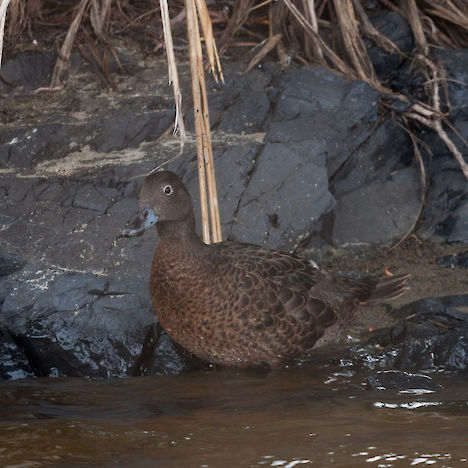Other names:
PatekeThreat category:
At Risk: Recovering?Regions:
Northland, Auckland, Wellington, WestcoastDistribution:
Natural remnant populations restricted to Northland, Great Barrier Island, and Coromandel. Reintroductions and expanding throughout
Description
- Brown teal are small, brown ducks; the male has a green head during the breeding season.
- Brown teal found on the New Zealand mainland have been split into two forms, North Island and South Island. The South Island brown teal (Anas chlorotis “South Island”) is only found in Fiordland. It is listed as ‘Data Deficient’ and is considered to probably be extinct.
Interesting Facts
- The brown teal population is estimated at 1,500-2,000 birds (2011).
- North Island brown teal are largely restricted to Great Barrier Island, Northland and some predator-free offshore islands to which they have been introduced. They were once widespread throughout New Zealand.
- Brown teal are often associated with farmland, and nest in riparian vegetation along streams, wetlands and estuaries, often feeding in damp pasture, lawns and drains, as well as more natural habitat such as estuaries and wet forest habitats.
- The North Island brown teal has been downgraded from Nationally Endangered to At Risk-Recovering as a result of a highly successful recovery programme involving intensive predator control.
- All wetland birds require high quality wetland habitat buffered from the effects of surrounding land management.
Association with Plantations
- Wetland birds are found in many plantation forests.
- Wetland birds may be hard to detect due to their elusive behaviour.
Threats
- Habitat loss and degradation from wetland drainage, loss of riparians, and the effects of surrounding landuse are general threats to all wetland birds.
- Invasion of exotic plants, which can seriously modify wetlands and their suitability for birds.
- High predation rates of some wetland bird species such as brown teal are well documented; the level of predation on many other species, however, is unknown
Management Options and Methods
- Habitat protection:
- Protect important wetland habitats and riparian buffers.
- Avoid using herbicides or pesticides close to wetlands.
- Ensure weeds are not inadvertently introduced to wetlands, e.g. via machinery or boats.
- Consider control options for existing, invasive, wetland weeds.
- Consider a staged removal of willows to ensure ongoing cover for crakes and ducks.
- Forest operations:
- Minimise damage to riparian and wetland habitat during road construction and harvest operations.
- Avoid grazing wetlands and their margins. Fencing may be appropriate in some situations.
- Avoid diverting run-off into wetlands.
- Minimise disturbance during spring breeding.
- If pateke are present, discuss predator control with neighbours and DOC.
- Injured or dead wetland birds (particularly the more threatened species, i.e. white heron, bittern and pateke):
- Place injured birds in a cardboard box (keep shaded) and deliver to a local vet, SPCA, DOC.
- Call DOC if bird is dead.
Monitoring Options
- Increase staff and contractor knowledge about wetland birds.
- For important wetlands that are likely to have the more threatened species, consider undertaking a bird monitoring programme:
- Counts of pateke flock sites in late summer.
- Fernbirds, spotless crakes and to a lesser extent marsh crakes and banded rails respond to taped playback calls.
- The booming calls of bittern are characteristic at dusk in September-October particularly during bright moonlight.
- Maintain a database of sightings.
Further Information and Support
Brown teal website: BrownTeal.com.
New Zealand Birds Online: brown teal.
Pateke Survival Guide 2011: a guide for landowners, community groups and other parties interested in the recovery of pāteke, published by the Department of Conservation.
Pest management: Department of Conservation, Regional Councils.



